
A narrated tutorial explains how to calculate the velocity of an object undergoing constant acceleration. [6:29]
- Subject:
- Science
- Material Type:
- Audio/Video
- Provider:
- Sophia Learning
- Date Added:
- 12/01/2023

A narrated tutorial explains how to calculate the velocity of an object undergoing constant acceleration. [6:29]
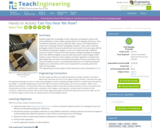
Students apply their knowledge of linear regression and design to solve a real-world challenge to create a better packing solution for shipping cell phones. They use different materials, such as cardboard, fabric, plastic, and rubber bands to create new “composite material” packaging containers. Teams each create four prototypes made of the same materials and constructed in the same way, with the only difference being their weights, so each one is fabricated with a different amount of material. They test the three heavier prototype packages by dropping them from different heights to see how well they protect a piece of glass inside (similar in size to iPhone 6). Then students use linear regression to predict from what height they can drop the fourth/final prototype of known mass without the “phone” breaking. Success is not breaking the glass but not underestimating the height by too much either, which means using math to accurately predict the optimum drop height.
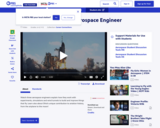
Watch three aerospace engineers explain how they work with experiments, simulations and wind tunnels to build and improve things that fly. Learn also about Ohio’s unique contribution to aviation history, from the airplane to the moon!

This site from Stanford University is on the topic of simultaneity in relativity.

Students learn about the physical force of linear momentum movement in a straight line by investigating collisions. They learn an equation that engineers use to describe momentum. Students also investigate the psychological phenomenon of momentum; they see how the "big mo" of the bandwagon effect contributes to the development of fads and manias, and how modern technology and mass media accelerate and intensify the effect.

A video module showing that to determine a decrease in momentum you should look at impulse. Videos explores the equation for impulse and its application. Also given in lesson is an example of how to decrease momentum. [4:59]

Video tutorial uses examples and formulas to show how to derive displacement as a function of time, constant acceleration, and initial velocity. [9:57]
Khan Academy learning modules include a Community space where users can ask questions and seek help from community members. Educators should consult with their Technology administrators to determine the use of Khan Academy learning modules in their classroom. Please review materials from external sites before sharing with students.
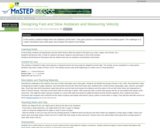
This activity is an inquiry lab where students are challenged to create a slow moving and fast moving plane and measure the speed.
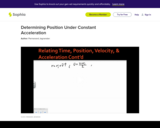
A narrated tutorial which shows how to find the position of an object undergoing constant acceleration. [8:48]
![Educaplus: Altura maxima y alcance [in Spanish]](https://openspace.infohio.org/static/newdesign/images/materials/default-thumbnail-index.png)
Perform oblique releases and observe the horizontal range and the maximum height of the projectile.
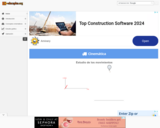
This site shows a cinematic study of rectilinear movements which requires the use of equations and graphs. Every day life applications are also shown.
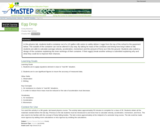
This activity is an outdoor lab where students gather data and calculate velocity, acceleration, momentum, and force of a vessel they create to safely deliver 2 eggs from the roof to the pavement below.

Under the "The Science Behind Harry Potter" theme, a succession of diverse complex scientific topics are presented to students through direct immersive interaction. Student interest is piqued by the incorporation of popular culture into the classroom via a series of interactive, hands-on Harry Potter/movie-themed lessons and activities. They learn about the basics of acid/base chemistry (invisible ink), genetics and trait prediction (parseltongue trait in families), and force and projectile motion (motion of the thrown remembrall). In each lesson and activity, students are also made aware of the engineering connections to these fields of scientific study.
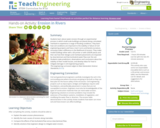
Students learn about water erosion through an experimental process in which small-scale buildings are placed along a simulated riverbank to experience a range of flooding conditions. They learn how soil conditions are important to the stability or failure of civil engineering projects and how a river's turns and bends (curvature, sinuosity) make a difference in the likelihood of erosion. They make model buildings either with a 3D printer or with LEGO® pieces and then see how their designs and riverbank placements are impacted by slow (laminar) and fast (turbulent) water flow over the soil. Students make predictions, observations and conclusions about the stability of their model houses, and develop ideas for how to mitigate damage in civil engineering projects.
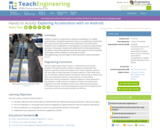
Students conduct an experiment to study the acceleration of a mobile Android device. During the experiment, they run an application created with MIT's App Inventor that monitors linear acceleration in one-dimension. Students use an acceleration vs. time equation to construct an approximate velocity vs. time graph. Students will understand the relationship between the object's mass and acceleration and how that relates to the force applied to the object, which is Newton's second law of motion.

All of us have felt sick at some point in our lives. Many times, we find ourselves asking, "What is the quickest way that I can start to feel better?" During this two-lesson unit, students study that question and determine which form of medicine delivery (pill, liquid, injection/shot) offers the fastest relief. This challenge question serves as a real-world context for learning all about flow rates. Students study how long various prescription methods take to introduce chemicals into our blood streams, as well as use flow rate to determine how increasing a person's heart rate can theoretically make medicines work more quickly. Students are introduced to engineering devices that simulate what occurs during the distribution of antibiotic cells in the body.
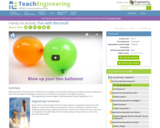
While we know air exists around us all the time, we usually do not notice the air pressure. During this activity, students use Bernoulli's principle to manipulate air pressure so its influence can be seen on the objects around us.
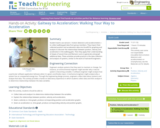
Student teams use sensorsâmotion detectors and accelerometersâto collect walking gait data from group members. They import their collected position and acceleration data into Excel® for graphing and analysis to discover the relationships between position, velocity and acceleration in the walking gaits. Then they apply their understanding of slopes of secant lines and Riemann sums to generate and graph additional data. These activities provide practice in the data collection and analysis of systems, similar to the work of real-world engineers.

First let's review position, velocity and acceleration vs. time curves. This video [2:56] focuses on developing mathematical formulas to do three things: Describe how particles move, how particles collide, and track particles forward through time.
Khan Academy learning modules include a Community space where users can ask questions and seek help from community members. Educators should consult with their Technology administrators to determine the use of Khan Academy learning modules in their classroom. Please review materials from external sites before sharing with students.

In this video segment from NOVA scienceNOW, learn about the effects of gravity as astrophysicist Neil deGrasse Tyson falls through a virtual hole through Earth's center. [1:45]